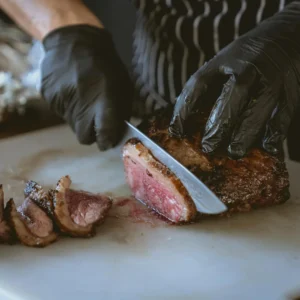Cutting Meat Technique: Importance of Slicing Against the Grain
Cutting meat technique is one of several essential methods chefs and home cooks use to ensure the best texture and flavour. Allowing the meat to reach room temperature before cooking and letting it rest after heat are crucial steps. These actions go beyond culinary traditions, significantly impacting the final dish. One particularly crucial technique is cutting meat against the grain. But what happens when someone overlooks or intentionally ignores this step?
Understanding Muscle Fibres in Meat: Cutting Meat Technique
 Muscle fibres make up the meat, and connective tissue holds them together. These fibres run in parallel lines throughout the meat and play a vital role in determining texture. Some cuts have fine, delicate fibres that contribute to their tenderness, while others contain coarser strands, making them naturally tougher.
Muscle fibres make up the meat, and connective tissue holds them together. These fibres run in parallel lines throughout the meat and play a vital role in determining texture. Some cuts have fine, delicate fibres that contribute to their tenderness, while others contain coarser strands, making them naturally tougher.
When meat is cooked, these fibres do not dissolve; instead, they remain intact, influencing how easily the meat can be chewed. This is where the importance of slicing technique comes into play. Cutting against the grain means slicing perpendicular to the muscle fibres, effectively shortening them and making each bite more tender. Conversely, slicing in the same direction as the grain results in long, intact fibres, which make the meat chewier and tougher to eat.
The Consequences of Cutting Meat with the Grain
Failing to slice against the grain has a noticeable impact on texture. While it may not render the meat inedible, it does make it significantly more difficult to chew, particularly for cuts with dense muscle fibres. The worst-case scenario occurs when meat is cut parallel to the grain. This maximises the length of each muscle strand, requiring excessive chewing effort.
For instance, tougher cuts such as skirt steak, flank steak, hanger steak, and brisket have particularly pronounced muscle fibres. If these cuts are not sliced correctly, the eating experience can become unpleasantly tough and stringy. By contrast, more tender cuts such as ribeye, New York strip, and filet mignon contain finer muscle fibres that make slicing direction less critical, though cutting against the grain can still enhance tenderness.
Exceptions to the Ruleslow-cooked dishes
 While slicing against the grain is almost always the best approach, there are a few exceptions. In slow-cooked dishes like beef stew or ropa vieja, the structure of the meat breaks down naturally over time due to prolonged exposure to heat and moisture. In such cases, the slicing technique before cooking becomes less relevant, as the meat will fall apart regardless.
While slicing against the grain is almost always the best approach, there are a few exceptions. In slow-cooked dishes like beef stew or ropa vieja, the structure of the meat breaks down naturally over time due to prolonged exposure to heat and moisture. In such cases, the slicing technique before cooking becomes less relevant, as the meat will fall apart regardless.
Additionally, certain premium cuts, such as those from the loin or tenderloin, have fibres so fine that slicing direction does not drastically impact texture. These cuts are naturally tender due to their marbling and composition. Even if not cut against the grain, they remain enjoyable to eat.
How to Identify the Grain in Meat
To ensure you are cutting meat correctly, it is essential to first identify the grain. This can be done by closely examining the surface of the meat before slicing. Look for the direction in which the muscle fibres run—this is the grain. Once identified, position your knife perpendicular to these lines and slice across them. For best results, use a sharp knife to make clean cuts, further enhancing the meat’s tenderness.
Final Thoughts: Cutting Meat Technique
While it may seem like a minor detail, cutting meat against the grain plays a crucial role in determining the texture and overall enjoyment of a dish. By taking the time to identify the grain and slicing perpendicular to it, you can ensure a tender and flavourful result. Some exceptions exist, particularly for slow-cooked dishes and highly marbled cuts. However, following this technique enhances most meat-based meals. Next time you prepare a steak or roast, remember: the way you slice truly makes a difference.